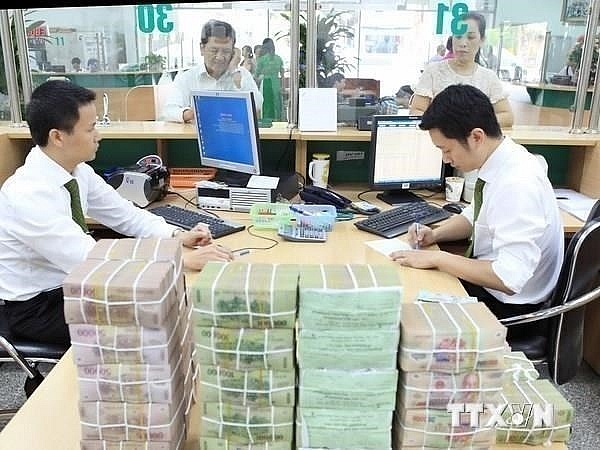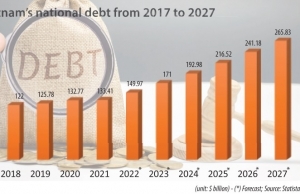Government looks ahead to financial security via debt plan
The government has submitted to the National Assembly Standing Committee a scheme for borrowing and paying public debt for 2024, based on expectations that the economy will grow 6-6.5 per cent next year, with state budget revenues of about $69.62 billion and a state budget deficit of as much as 3.6 per cent of GDP.
 |
| Government looks ahead to financial security via debt plan, Illustrative image (Source: VNA) |
Many international organisations have set a positive economic growth target for Vietnam including the International Monetary Fund (5.8 per cent), the World Bank (5.5 per cent), the Asian Development Bank (5.8 per cent), Moody’s (5.6 per cent), and Fitch Solutions (5 per cent).
These projections have inspired the government to devise the public debt scheme for next year. Under the scheme, in 2024, the government’s total loans will be $28.52 billion, including $15.73 billion for borrowing to offset the central budget deficit, $12.1 billion for borrowing to pay the principal debt of the state budget, and $680.3 million for on-lending.
“These loans will come from many sources, including issuance of government bonds, official development assistance (ODA) and foreign concessional loans, and other legal financial sources,” said Minister of Finance Ho Duc Phoc.
When it comes to the government’s debt payment obligations for next year, based on the government’s existing debt portfolio, it is estimated that the government’s direct debt payment is $16.7 billion and the payment of on-lending projects is $2.45 billion.
It is estimated that by late 2024, the government’s direct debt payment will be ensured at a cap of 25 per cent of the state budget revenues as stipulated by the National Assembly (NA).
When it comes to the loan and payment plan of localities, their total borrowing for the whole of 2024 will be about $1.3 billion, largely coming from ODA, the government’s concessional loans, and other domestic sources. Localities’ total debt payment will be about $173.8 million, and total debts by late 2024 will be as much as $4 billion.
With the estimated borrowing and payment of government debt, government-guaranteed debt, debt of authorities, and self-borrowed and self-paid foreign debt of enterprises and credit institutions, if positive GDP growth meet targets assigned by the NA, it is forecast that by the end of 2024, Vietnam’s total public debt will be about 39-40 per cent of GDP. Meanwhile, the government debt will be about 37-38 per cent of GDP and the nation’s foreign debt will be as much as 38-39 per cent of GDP.
The government’s direct debt payment obligation compared to the estate budget revenue will stand at about 24-25 per cent, guaranteed to stay “within the cap and threshold allowed by the NA”, according to the Ministry of Finance (MoF).
The government also reported that this year, the NA approved a total loan amount of $26.2 billion for the central budget, of which borrowing to offset central budget overspending sat at $18.16 billion, equal to 4.18 per cent of GDP, and borrowing to pay principal of the central budget stood at more than $8 billion.
In addition, the government also approved its own on-lending plan of ODA loans and foreign concessional loans worth $987 million.
In order to secure capital, the government has mobilised from domestic sources, ODA loans, and preferential loans from foreign donors. Based on the implementation of the first nine months of this year, the government expects the mobilised sum for the whole of 2023 to reach $25.5 billion, tantamount to 93.8 per cent of the plan.
Of which, domestic loans will likely be more than $23 billion, largely via government bond issuances, and ODA and foreign donors’ concessional loans will likely be over $2.4 billion.
According to the MoF, to continue to create capital for development investment in 2023 and beyond, the government expects that in 2023 it will complete the negotiation and signing of 17 ODA loan agreements, and foreign preferential loans with a total value of about $1.87 billion.
This includes one loan worth ¥50 billion ($335 million) from the Japanese government, and one International Development Association loan from unused projects of the World Bank worth $264 million in the form of budget support to supplement capital to carry out the tasks of the Programme on Socioeconomic Recovery and Development, expected to withdraw all capital this year.
“New loans negotiated and signed from 2022 now have higher lending rates, closer to the market, reflecting the change in lending policies of donors given the country’s lower middle-income status,” Minister Phoc said.
Also this year, the government’s total debt payment is estimated to reach $13.14 billion, including $11.8 billion for direct debt payment and $1.34 billion for on-lending.
| The sixth session of the 15th National Assembly is scheduled to take place from October 23 to November 29 in Hanoi. The NA schedules to discuss and adopt many laws, including: - Law on Land (amended) - Law on Real Estate Business (amended) - Law on Housing (amended) - Law on Water Resources (amended) - Law on Telecommunications (amended) - Law on Management and Protection of Defence Works and Military Zones The NA will also provide comment for many other laws, including: - Law on Social Insurance (amended) - Law on Archives (amended) - Law on Defence Industry and Security and Industrial Mobilisation - Law on Roads - Law on Road Traffic Order and Safety - Law on Capital (amended) - Law on the Organisation of People’s Courts - Law amending and supplementing articles of the Law on Property. In addition, the NA may also debate and decide on other key issues. They include the pilot application of incentives for high-tech investments; the global minimum tax; policies to remove obstacles for road ventures; collection of toll fees at state-funded expressways; and a law revising many laws to remove difficulties in order to mobilise resources for boosting business and production activities. The NA is also expected to approve the UK’s membership of the Comprehensive and Progressive Agreement for Trans-Pacific Partnership. The legislature will also review and decide important matters related to socioeconomic issues and the state budget, such as reports on the implementation of the socioeconomic development plan and state budget for 2023, and related matters in preparation for 2024. |
 | Public debt management picture clears towards 2025 Vietnam’s plan for borrowing and paying public debt has been revealed, and the budget landscape finalised for this year, with public debt set to stay within the permissible limit. |
 | Uncertainty must be taken into account in promoting growth The global economy has seen some positive signs despite numerous risks and challenges that include inflation, financial and monetary instability, high public debt in developing countries, impacts from the Russia-Ukraine conflict, and instability in energy and food markets, among other areas. |
What the stars mean:
★ Poor ★ ★ Promising ★★★ Good ★★★★ Very good ★★★★★ Exceptional
Related Contents
Latest News
More News
- Tax sector wraps up 2025 and sets priorities for next year (December 25, 2025 | 14:00)
- A tipping point for digital and hybrid wealth management in Vietnam (December 23, 2025 | 13:33)
- $250 million deal targets women-owned SMEs, sustainable agriculture (December 22, 2025 | 17:40)
- Stock market posts resilient 2025 performance (December 19, 2025 | 18:17)
- Citi Vietnam receives 2025 AmCham CSR recognition (December 19, 2025 | 16:35)
- As global green supply chain reshapes, will Vietnam be left behind? (December 19, 2025 | 08:00)
- Banks gear up for massive capital increases (December 18, 2025 | 17:04)
- Securing capital and efficiency for Vietnam’s 2026-2030 growth ambitions (December 17, 2025 | 10:00)
- Energy sector in need of blended finance mechanisms (December 17, 2025 | 09:00)
- Vietnam still has room to mobilise capital for sustainable growth (December 17, 2025 | 08:57)

 Tag:
Tag:





















 Mobile Version
Mobile Version